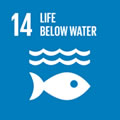Por favor, use este identificador para citar o enlazar a este item:
http://hdl.handle.net/10261/305832COMPARTIR / EXPORTAR:
 SHARE SHARE
 CORE
BASE CORE
BASE
|
|
| Visualizar otros formatos: MARC | Dublin Core | RDF | ORE | MODS | METS | DIDL | DATACITE | |

| Título: | Spatial distribution of the demersal chondrichthyan community from the western Mediterranean trawl bycatch |
Autor: | Ruiz-García, David; Raga, Juan Antonio; March, David CSIC ORCID; Colmenero, Ana I. CSIC ORCID ; Quattrocchi, Federico CSIC; Company, Joan B. CSIC ORCID ; Recasens, Laura CSIC ORCID ; Barría, Claudio CSIC ORCID | Palabras clave: | Environmental drivers Fishing pressure Commercial bottom trawling Diversity Elasmobranchs Shark Rays Modelling |
Fecha de publicación: | mar-2023 | Editor: | Frontiers Media | Citación: | Frontiers in Marine Science 10: 1145176 (2023) | Resumen: | Introduction: Chondrichthyans (sharks, batoids and chimaeras) play key roles in the regulation of marine food webs dynamics. However, more than half of the assessed species in the Mediterranean are threatened, primarily by fishing pressure and compounded by habitat degradation and climate change. Nevertheless, there is an important knowledge gap in identifying the underlying drivers of their community structure and spatial distribution. Methods and Results: We provide insights into the current bycatch rates of chondrichthyans in the western Mediterranean commercial bottom trawling fishery by accurately depicting the unaltered practices of the local fleet. A total of 17 species were recorded in the studied fishing grounds (ranging from 50 to 800 m deep), including 7 sharks, 9 batoids, and 1 chimaera, although the total catch was dominated by few species. Furthermore, we tested the effect of environmental and fishing-related factors on multiple community descriptors by using analysis of community structure (multidimensional scaling and analysis of similitude) and generalized linear mixed models to further understand the drivers of the chondrichthyan community distribution and structure. This study revealed the importance of combining environmental and anthropogenic drivers to further understand the spatial distribution patterns of chondrichthyan communities. Our results indicate that depth was the main driver of the community structure, with deeper areas within the fishing grounds hosting a higher diversity. Sea bottom temperature and substrate type also influenced the distribution of the community, with substrate effects changing depending on the intensity of fishing pressure. In all cases, density, biomass, and diversity of chondrichthyans were negatively impacted by increasing fishing effort. Discussion: Understanding the drivers of the structure and distribution of the chondrichthyan community is crucial to understand the potential impacts that increased fishing pressure, habitat loss and global change may entail. The ongoing challenges that the Mediterranean chondrichthyans and their ecosystems are facing highlights the need for continued monitoring and improved chondrichthyan-focused fisheries management | Descripción: | 15 pages, 4 figures, 4 tables, supplementary material https://www.frontiersin.org/articles/10.3389/fmars.2023.1145176/full#supplementary-material.-- Data availability statement: The raw data supporting the conclusions of this article will be made available by the authors, without undue reservation | Versión del editor: | https://doi.org/10.3389/fmars.2023.1145176 | URI: | http://hdl.handle.net/10261/305832 | DOI: | 10.3389/fmars.2023.1145176 | E-ISSN: | 2296-7745 |
| Aparece en las colecciones: | (ICM) Artículos |
Ficheros en este ítem:
| Fichero | Descripción | Tamaño | Formato | |
|---|---|---|---|---|
| Ruiz_Garcia_et_al_2023.pdf | 7,17 MB | Adobe PDF |  Visualizar/Abrir | |
| Ruiz_Garcia_et_al_2023_suppl.DOCX | 676,56 kB | Microsoft Word XML | Visualizar/Abrir |
CORE Recommender
SCOPUSTM
Citations
5
checked on 22-abr-2024
WEB OF SCIENCETM
Citations
3
checked on 19-feb-2024
Page view(s)
61
checked on 27-abr-2024
Download(s)
51
checked on 27-abr-2024
Google ScholarTM
Check
Altmetric
Altmetric
Este item está licenciado bajo una Licencia Creative Commons



